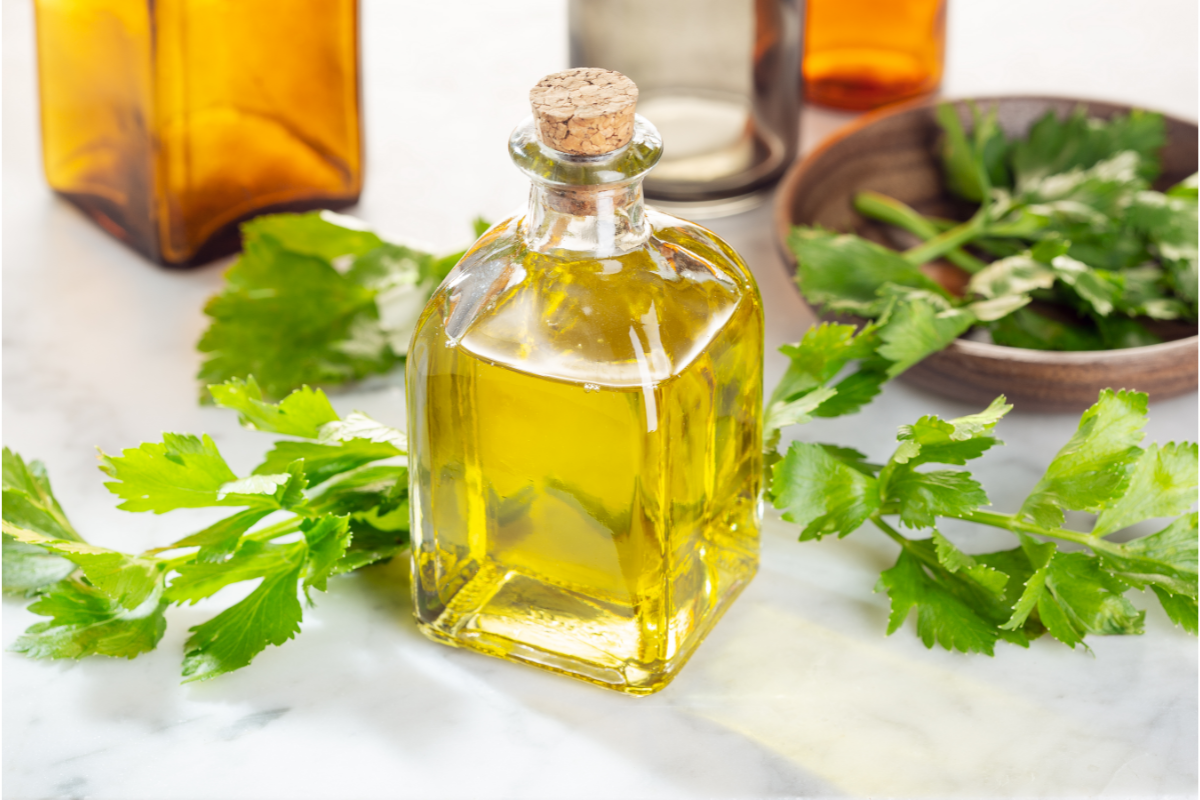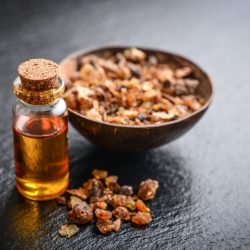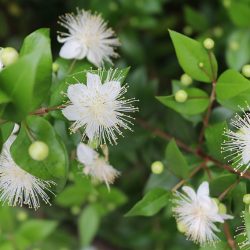Welcome to the fascinating world of aromatherapy, where each essence reveals its secrets. Today, we’re exploring one of nature’s treasures: celery essential oil. This plant extract, derived from celery(Apium graveolens), a plant in the Apiaceae family, is packed with health and well-being benefits. Prized for its digestive, detoxifying and even anti-cancer properties, celery essential oil is an ideal ally in the quest for a healthier life.
In this article, we invite you to delve into the mysteries of celery. From its unique chemical composition, rich in limonene and phthalides, to its many therapeutic applications, we’ll look at every facet of this captivating essential oil. Whether it’s to soothe your mind, improve your digestion, or care for your skin, celery essential oil is proving to be a remedy natural remedy natural remedy.
Join us on this aromatic journey and discover how to incorporate celery essential oil into your daily routine for optimum health and enhanced well-being.
What are the characteristics of Celery?
Celery, whose botanical name is Apium graveolens, is a member of the Apiaceae family.
What are its botanical attributes?
Celery is a biennial plant ranging in stature from 30 to 80 cm, distinguished by its smooth, shiny surface and bewitching aromatic fragrance. It has a short stump with slightly fleshy fibres, and a hollow, furrowed, angular stem that extends into a highly branched structure.
Celery leaves are somewhat thick, with pinnate lower leaves made up of wedge-shaped, incised and lobed oval segments, while the upper leaves have three smaller, narrower segments.
At its peak, celery unfurls whitish umbels, borne on short peduncles or subsessiles, with 6 to 12 unequal rays. An intriguing feature is the absence of involucre and involucellum, and the limbless calyx.
Celery petals are suborbicular, heart-shaped, flat and entire, with a slightly curled tip. At the base of the petals is a depressed stylopod.
What is its natural environment?
The celery fruit is small, almost symmetrical, subglobose, compressed on the side and hairless. The celery’s mericarps are made up of five units, each with uniform, whitish-coloured, thread-like ribs, embellished by valleculae with a discreet band.
Celery grows in salt marshes on the Channel, Ocean and Mediterranean coasts, as well as in inland salt springs. This exceptional plant is found on the European, Asian, African and American continents, and is widely cultivated wherever it flourishes.
Celery blooms majestically between July and September, offering a delicate botanical symphony to those lucky enough to observe it. Every element of this plant seems to contribute to its beauty and harmony in nature.
How does Celery Essential Oil work?
The characteristics of Celery Essential Oil derive from the presence of active compounds originating in the seeds of Apium graveolens, more commonly known as Celery (cultivated), Sweet Celery, Sweet Clover, Marsh Clover or Marsh Parsley.
How does it work?
Celery essential oil is made up of :
- Monoterpenes: limonene (70%)
- Sesquiterpenes: beta-selinene (10%), alpha-selinene (1.5%)
- Phthalides: sedanolide (3%), butyl-phthalide (2%)
- traces of Coumarins (Celerin, apigravin, ombelliprenin)
Celery essential oil, rich in limonene and phthalides such as sedanolide, promotes drainage of the urinary and biliary tracts, speeding up the body’s detoxification process. These compounds have sedative and relaxing properties. Celery essential oil acts as an anxiolytic, helping to manage stress and anxiety.
What’s more, its high limonene content encourages the liver to produce and secrete bile, which aids digestion. Celery also has depigmenting properties thanks to its phthalide molecules, which act directly on pigments and brown spots by detoxifying them.
It also has secondary properties such as venous decongestant, anti-infectious, repellent and expectorant action.
Limonene is said to protect against cancer of the skin, liver, breast and colon. Monoterpenes act in a similar way to cortisone. Phthalides have detoxifying properties.
What are its indications?
Celery essential oil has a number of beneficial properties that have been scientifically proven. It acts as a highly effective digestive tonic, aiding digestion, with a mild aperitif effect. It helps to drain and stimulate the hepatocytes, the liver cells, and the kidneys. Thanks to its compounds, it has sedative and calming properties. It helps to relieve congestion in the veins. Its anti-pigmentation properties are beneficial for the skin.
It is beneficial in cases of intoxication and can treat cystitis and promote kidney detoxification. This oil is useful in cases of gout and can relieve minor hepatic insufficiency and liver congestion. It helps relieve flatulence and fight bad breath. It is also recommended for varicose veins and haemorrhoids.
In cosmetics, celery essential oil is appreciated for its action on anti-pigmentation. It can be beneficial for reducing skin spots, signs of ageing and marks left by the sun.
On an energetic level, the olfactory use of celery essential oil is particularly suitable for people in hyper-control situations.
How should I use this essential oil?
Celery essential oil can be used in a wide range of ways to treat a variety of conditions and symptoms. However, if you are unsure, we strongly advise you to consult a healthcare professional for personalised, safe information tailored to your state of health, profile and age.
What dosage should I choose?
To apply celery essential oil to the skin, dilute one drop of essential oil in 20 drops of vegetable oil. Here are some specific indications after dilution:
- Brown spots, age spots, psoriasis: apply to the area concerned.
- Digestive problems: massage into the stomach in a circular motion
- High blood pressure: apply to the forearms and soles of the feet.
- Varicose veins and circulatory problems (heavy legs, oedema, etc.): Massage the legs, moving upwards towards the heart
- Anxiety: massage the back and soles of the feet
- Improving sleep: Dilute the essential oil in a vegetable oil and massage the back.
- Specific pain: To treat localised pain, massage the painful area.
- Liver disorders (detoxification, liver overload, viral hepatitis, cirrhosis, jaundice, liver poisoning, etc.): massage the liver area.
It is essential to consult a doctor before taking this essential oil orally. This essential oil should only be taken on medical advice and for a limited period only. In the case of intoxication, for example, it can be administered at the rate of one drop, three to five times a day, under the supervision of a health professional.
Celery essential oil can be used to improve well-being by inhalation. There are two main methods:
- Wet inhalation: Dilute a few drops of essential oil in a container of warm water, then inhale the vapours.
- Dry inhalation: Apply a few drops of celery essential oil to a support. Inhale occasionally to benefit from its effects.
You can also diffuse celery essential oil in the air to promote well-being, reduce anxiety, depression or fatigue, and stimulate the appetite. If necessary, it can be mixed with other essential oils for diffusion.
What are the contraindications?
It should be noted that celery essential oil contains coumarins and can cause photosensitivity. You should therefore avoid exposure to the sun for at least 8 hours following its application to the skin.
Due to its potentially oestrogen-like properties, pregnant women should not use this essential oil. Children under the age of 8 should not use this essential oil, as their immune systems may be sensitive.
People who are sensitive to allergic reactions should avoid celery essential oil. Before use, it is advisable to carry out an allergy test by applying a small amount of essential oil to the crease of the elbow to check that no allergic reaction occurs.
What is the fascinating history of celery?
Originally called “ache”, a term meaning “to grow in water” in reference to its aquatic habitat, celery used to refer to a fairly broad group of plants, including members such as parsley and lovage. It wasn’t until the 17th century that the term “celery” was specifically attributed to a particular plant, believed to be influenced by the moon and endowed with aphrodisiac properties. The origin of the word “celery” goes back to an Italian dialect, Lombard, where it was spelt “seleri”. This name seems to derive from the Latin “selinon”, which originally referred to the plant in Greek.
How important was celery in ancient times?
Celery has been a valued plant, especially as a vegetable, since ancientEgypt and Greece (where it was known as “selinon”, plant of the Moon) and as far back as Rome. Homer probably mentioned celery as early as 800 BC in The Odyssey.
Native to the Mediterranean basin, in particular the salt marshes bordering the Mediterranean, the ancient Greeks were already familiar with celery. The Egyptians harvested the leaves, stalks and seeds of this plant to flavour their dishes. It is important to note that the variety of celery we know today, with its fleshy, water-rich ribs, did not exist at that time. The Greeks and Egyptians mainly used a bunch of sparsely developed stalks.
In Asia, on the other hand, celery seeds had long been used for their medicinal properties. The precious essential oil of celery is extracted from its seeds. The Chinese and Egyptians were already using it 500 years before our era. For centuries, celery came in the form of a bouquet with spindly stalks and was used as an aromatic.
The celery stalk is descended from a Mediterranean medicinal and decorative plant called ache or apion. Originating on the Italian peninsula, the Greeks used it daily from ancient times as a medicinal and then aromatic plant.
How did celery evolve from the Renaissance onwards?
In the 13th century, Pierre de Crescences wrote that “the wild ark purges the melancholic humours that cause sadness”. Like its cousin the celeriac, the celeriac is derived from marsh ache and was first recognised for its medicinal rather than gustatory virtues. What’s more, it was thought to have all kinds of almost ” magical ” powers: curing melancholy, choosing the sex of an unborn child, fighting toothache, etc.
It wasn’t until the Renaissance that it was incorporated into vegetable gardens. It was improved empirically in the growing regions that gave their names to the old varieties: Gennevilliers, Rueil, Prague and Erfurt. Celeriac cooked from the Renaissance onwards was still just a condiment. After a diversion through Germany, the vegetable made its way onto French plates in the 19th century.
It was not until the 17th century that France and Germany really began to take an interest. There are many names for this species, such as celery (also known as cèleri), ache des marais, ache odorante, ache puante, persil des marais, persil odorant, céleri d’Italie…
The plant as we know it today originated in 17th century Italy. Selective cultivation created two types of celery: one with particularly long, fleshy stalks (celeriac); the other with large roots and small, leafy stalks (celeriac). They were not introduced to France until a century or two later.
But it wasn’t until the middle of the 19th century that celery made a permanent appearance in our kitchens and on our plates.
What is the situation today?
Today, there are four main varieties of celery, three of which are commonly grown:
- Apium graveolens var. graveolens: themarsh ache;
- Apium graveolens var. dulce: ribbed celery;
- Apium graveolens var. rapaceum, celeriac or celery root;
- Apium graveolens var. secalinum: chopped or Chinese celery.
According to Lieutaghi, the genus name Apium comes from the Sanskrit Apya meaning “that grows in water”. The cultivated forms are celery , of which the stalks or root (celeriac) are eaten. Used in the form of “diuretic syrup” or “five-root syrup” with Ache, Asparagus, Fennel, Parsley and Holly.
References
- Properties and Uses of Celery Essential Oil:
- PasseportSanté.net offers a detailed article on the properties of celery essential oil, including its digestive tonic, anti-cancer, anti-pigmentary, draining, detoxifying, calming and sedative effects. They also explain its various uses, and highlight the precautions to be taken when using this essential oil.
- Anti-cancer properties of Limonene:
- A clinical study by the University of Arizona showed that limonene, a key component of celery essential oil, has antioxidant, anti-inflammatory and anti-cancer properties. It has been shown to reduce the risk of cutaneous squamous cell carcinoma and stabilise the disease in the colon and breast.
- In a clinical trial conducted by researchers at the University of Arizona Cancer Center, daily intake of limonene was found to significantly reduce cyclin D1 expression, which can lead to cell cycle arrest and reduced proliferation of cancer cells in women with breast cancer.
- A case-control study conducted by researchers at the University of Arizona revealed that consumption of citrus peel, rich in D-limonene, was associated with a reduced risk of squamous cell carcinoma of the skin.
- General bibliography on Aromatherapy and Essential Oils:
- For a deeper understanding and general references on essential oils, including celery oil, the following books are recommended: “Petit Larousse des Huiles Essentielles”, “Bible Larousse des Huiles Essentielles”, “ABC de l’herboristerie familiale”, “Traité approfondie de Phyto-Aromathérapie” and “L’aromathérapie exactement”.





